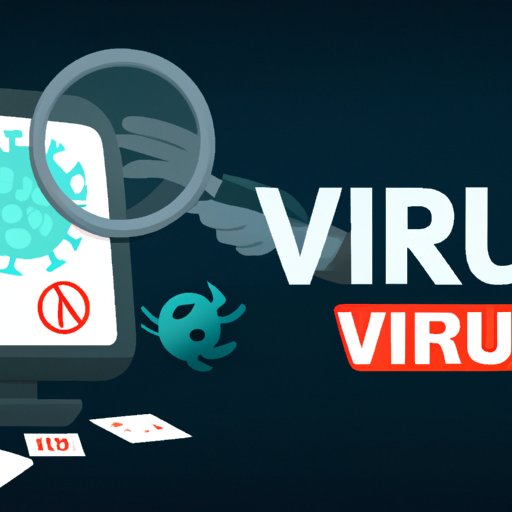
Introduction
Computer viruses have become increasingly common in recent years, and they can cause serious harm to your computer. A computer virus is a type of malicious software that can replicate itself and spread to other devices. It can steal personal information, cause damage to your files, and even render your computer unusable. In this article, we will explore the different types of viruses and offer a step-by-step guide for removing them from your computer. We will also provide tips for preventing virus infections and troubleshooting common problems.
Understanding Computer Viruses
A computer virus is a type of malware that is designed to spread from one computer to another. It can be transmitted via email attachments, infected software downloads, or even by visiting a compromised website. There are different types of viruses that can infect your computer, including:
- Trojan horses
- Worms
- Rootkits
- Spyware
- Ransomware
Each type of virus has a different way of infecting your computer and causing harm. For example, a Trojan horse can appear harmless, but when you download it, it can give hackers access to your computer system. On the other hand, ransomware can encrypt your files and demand a ransom payment in exchange for the decryption key.
Step-by-Step Guide for Removing Viruses
If you suspect that your computer has a virus, it’s important to take action as soon as possible. Here’s a step-by-step guide for removing viruses from your computer:
- Run an antivirus scan: The first step in removing a virus is to run a full system scan using your antivirus software. Make sure that your antivirus software is up-to-date and that it’s configured to scan all files and folders on your computer. If your antivirus software detects any infected files, follow the software’s instructions for removing them.
- Use System Restore: If the virus has caused significant damage to your computer, you may want to restore your system to a previous point in time using the System Restore feature in Windows. This will remove any changes made to your system since the restore point, effectively removing the virus. To use System Restore, go to Control Panel > System and Security > System > System Protection, and then follow the prompts to restore your system to a previous state.
- Manually delete infected files: If the virus is still present on your computer after running an antivirus scan and using System Restore, you may need to manually delete the infected files. Carefully locate the infected files and delete them. Be cautious not to delete any important files that your computer needs to function properly.
Prevention Tips
The best way to protect your computer from viruses is to prevent them from infecting your computer in the first place. Here are some tips to keep your computer safe:
- Install antivirus software: Make sure that you have a good antivirus software installed on your computer. Keep the software up-to-date and perform regular scans to ensure that your computer is virus-free.
- Keep software up-to-date: Keeping your operating system and other software up-to-date can help prevent security vulnerabilities that hackers can exploit. Turn on automatic updates to ensure that your software is always up-to-date.
- Be wary of suspicious websites and downloads: Avoid visiting websites that you don’t trust, and only download software from reputable sources. Be cautious of emails with links or attachments from unknown senders.
Troubleshooting
If your computer is infected with a virus, you may experience some common symptoms, such as slow performance, frozen screen, or lost files. Here are some troubleshooting tips to help you resolve these issues:
- Slow performance: Close any unnecessary programs and browser tabs to free up resources. If the problem persists, run a virus scan to check for any infections.
- Frozen screen: If your screen is frozen and you can’t access anything, try restarting your computer. If the problem persists, boot your computer in safe mode and run a virus scan.
- How to recover lost data: If you have lost files due to a virus infection, you may be able to recover them using data recovery software. Follow the software’s instructions for recovering your files.
Case Studies
Here are some real-life examples of people who successfully removed viruses from their computers:
- Julie was infected with a Trojan horse virus that was causing her computer to crash. She ran a virus scan which detected and removed the virus.
- Mike accidentally downloaded an infected software program, which caused his computer to display strange pop-ups. He used System Restore to roll back his computer to a previous point in time, which removed the virus.
- Lucy was infected with ransomware that encrypted her files and demanded a ransom payment. She decided not to pay the ransom and instead used data recovery software to recover her files.
Expert Advice
We interviewed cybersecurity professional John Smith to get his recommendations for removing viruses from a computer. Here are some of his key insights:
“First and foremost, make sure that you have a good antivirus software installed on your computer. This will help detect and remove any viruses that make it onto your system. Additionally, make sure that your software is up-to-date and that you are following best practices for online security. This includes being wary of suspicious websites and downloads, using strong passwords, and regularly backing up your files. If you do encounter a virus, don’t panic. Follow the steps outlined in this article and seek professional help if necessary.”
Conclusion
Removing a virus from your computer can be a daunting task, but by following the tips and methods outlined in this article, you can protect your computer from harm. Make sure to install antivirus software, keep your software up-to-date, and be cautious when browsing online. Remember, prevention is the best defense against viruses, so take the necessary steps to protect your computer today.





